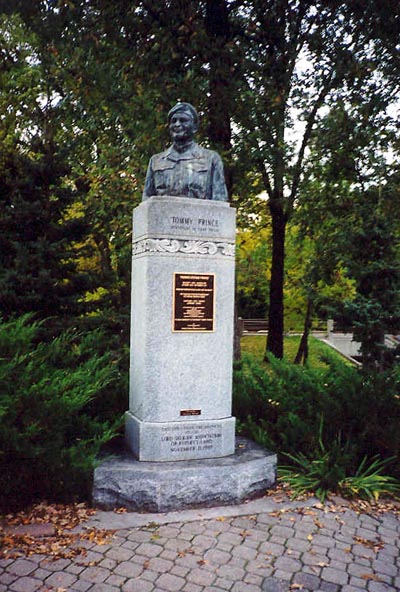Sergeant Tommy Prince Memorial
Municipality/Province: Winnipeg, MB
Memorial number: 46009-037
Type: Bust - bronze, shaft - granite
Address: Pequis and Lord Selkirk Drives
Location: Kildonan Park
GPS coordinates: Lat: 49.9439462 Long: -97.1049356
Submitted by: Tamara Wally
The Sergeant Tommy Prince Memorial, unveiled by the Princess Patricia's Canadian Light Infantry and the Lord Selkirk Association of Rupert's Land on 11 November 1989, is dedicated to the memory of Sergeant Thomas (Tommy) George Prince, soldier with the Princess Patricia's Canadian Light Infantry and winner of the Military Medal. The life-sized bronze bust of Tommy in military uniform and a beret, sits on a tall limestone block. The bust was sculpted by Otakar Pavlik. A statue of his great-grandfather, Chief Peguis is just a few steps away.
Sergeant Tommy Prince was a prominent Anishinaabe activist who served in the Second World War and Korean War. His story is one of the most widely known examples of the wartime contributions of Indigenous soldiers in the mid-20th century and the poor treatment they received upon their return to civilian life in Canada. His accomplishments attracted national media attention during his lifetime and earned him a great many posthumous tributes.
Prince was born in October 1915 in St. Peter's Reserve, Manitoba. He was the great-grandson of respected Ojibwa Chief Peguis, and one of eleven children born to Elizabeth and Henry Prince. In 1920, they moved to Brokenhead Ojibway Nation in Scanterbury, Manitoba. At age five, Prince was forced to leave his community and attend Elkhorn Residential School, where he joined the Cadet Corps. He suffered from post-traumatic stress disorder from the residential school before he joined the military.
In 1940, he volunteered to fight for Canada in the Second World War. He rose from sapper to lance corporal with the Royal Canadian Engineers before volunteering for the 1st Canadian Parachute Battalion in 1942. Soon after, he was assigned to the elite 1st Canadian Special Service Battalion, which was attached to the First Special Service Force (Devil’s Brigade). He reached the rank of sergeant by war’s end, and was one of three Canadians to receive both the Silver Star (United States) and the Military Medal. King George VI presented him with both honours during a ceremony at Buckingham Palace in 1945, shortly before Prince’s discharge from the army.
He wanted to prove his people were as good as any white man and restore their good name. One way to achieve this was to acquire as many medals as possible and he did so without putting his men at risk. Before any patrols he would ensure they were camouflaged and everything was secured. Often he would patrol alone because there would be less noise. Prince was a natural warrior and he excelled as the military developed the skills he learned on the reserve while living off the land. He loved the Devil's Brigade and was always praising his men, "If it wasn't for my men, I wouldn't be who I am today." He was a caring man who loved to joke around and make people laugh.
He was a prominent leader in the Indigenous rights movement of the 1940s. After the war, he served as spokesperson and vice-president of the Manitoba Indian Association, and appeared on its behalf before a Special Joint Committee of the Senate and House of Commons, tasked with studying the Indian Act. During his testimony in 1947, he advocated for the abolition of the Indian Act and respect for existing treaties, and presented submissions from Indigenous in Manitoba, which called for improved schools, better living conditions, and expanded hunting, trapping, and fishing rights.
In 1950, Prince re-enlisted in the Korean War. He contributed to the defence of Hill 677 in the Battle of Kapyong in 1951, for which the United States awarded the Princess Patricia’s Canadian Light Infantry the Distinguished Unit Citation—the only time a Canadian unit has received this honour. Military service took a heavy toll on his health and, following his honourable discharge from the army, he faced a difficult return to civilian life in Manitoba. Prince endured discrimination, illness, and poverty in the years that followed and died in 1977. He fought many demons after residential school and the horrors of combat, but he never lost his humility, self-worth, sense of humour and pride of being Anishinaabe.
Inscription found on memorial
TOMMY PRINCE
DESCENDANT OF CHIEF PEGIUS
THOMAS GEORGE PRINCE
MILITARY MEDAL - SILVER STAR
OCTOBER 1915 - NOVEMBER 1977
PRINCESS PATRICIA'S CANADIAN LIGHT INFANTRY
1ST CANADIAN PARACHUTE BATTALION
1ST SPECIAL SERVICE FORCE
ALEUTIANS - ITALY - FRANCE
GERMANY - KOREA
TAKE THESE MEN, THEN, AS YOUR EXAMPLE,
LIKE THEM
REMEMBER THAT PROSPERITY
CAN BE ONLY FOR THE FREE.
THAT FREEDOM IS THE PURE POSSESSION
OF THOSE ALONE
WHO HAVE THE COURAGE TO DEFEND IT.
PLACED IN THE MEMORY OF SERGEANT TOMMY PRINCE
BY
THE OFFICERS AND MEN
OF
PRINCESS PATRICIA'S CANADIAN LIGHT INFANTRY
SCULPTOR OTAKAR PAVLIK
ERECTED UNDER THE AUSPICES OF THE LORD SELKIRK ASSOCIATION OF RUPERT'S LAND
NOVEMBER 11, 1989
Street view
Note
This information is provided by contributors and Veterans Affairs Canada makes it available as a service to the public. Veterans Affairs Canada is not responsible for the accuracy, currency or reliability of the information.
- Date modified:
